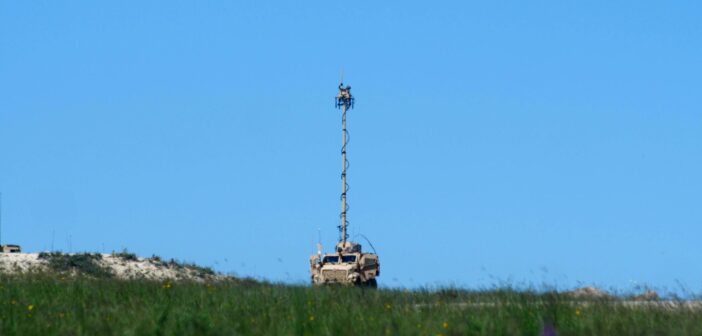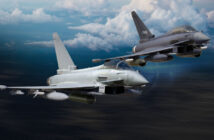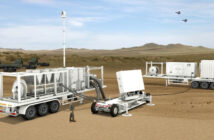This article first appeared in the JED October 2019 issue.
By John Haystead
The Program Executive Office (PEO) Intelligence Electronic Warfare & Surveillance (IEW&S) and the Command, Control, Communications, Computers, Cyber, Intelligence, Surveillance and Reconnaissance (C5ISR) Center are the core sources of the US Army’s EW and SIGINT capabilities. Both organizations are located at Aberdeen Proving Ground, MD.
PEO IEW&S is the Army’s lead organization for developing, acquiring and fielding a broad range of advanced electronics technology and systems for its ground and airborne forces, as well as its space-based capabilities in support of their IEW&S mission responsibilities. In addition to its headquarters at APG, it also includes facilities at Fort Belvoir, VA; Redstone Arsenal, AL, and Los Angeles AFB, CA.
The PEO is composed of six Project Manager (PM) elements: Aircraft Survivability Equipment; Distributed Common Ground System – Army; DOD Biometrics; Electronic Warfare & Cyber (EW&C); Position, Navigation & Timing; and Terrestrial Sensors. In addition, there are two Project Director (PD) offices: Tactical Exploitation of National Capabilities (TENCAP) and Sensors Aerial Intelligence.
Following the transition to Army Futures Command in February 2019, RDECOM changed its name to the Combat Capabilities Development Command (CCDC). Formerly known as CERDEC, the C5ISR Center is now one of eight science and technology “domains” within the CCDC, serving as the Army’s information technologies and integrated systems center, conducting R&D programs in command, power and integration; intelligence and information warfare; night vision and electronic sensors; and space and terrestrial communications. The C5ISR Center incorporates the Intelligence and Information Warfare Directorate (I2WD), which is the Army’s primary center for EW and SIGINT science and technology R&D.

The work of both PEO IEW&S and the C5ISR Center must necessarily support, and be synchronized with, the Army Futures Command (AFC) (Austin, TX) and its eight Cross Functional Teams (CFTs): Long-Range Precision Fires (LRPF); Next Generation Combat Vehicle (NGCV); Future Vertical Lift (FVL); Army Network; Assured Precision Navigation & Timing (PNT); Air & Missile Defense (AMD); Soldier Lethality (SL); and Synthetic Training Environment (STE).
Speaking at a recent media day sponsored by both PEO IEW&S and the C5ISR Center, BG Robert Collins, Program Executive Officer IEW&S, said, “In terms of modernization, we spend a lot of time making sure we’re both ready today, and posturing ourselves to modernize for the future. We do a significant amount of coordination with, and through, AFC here with our CFTs.” As examples, he cited their work “mapping” to the Network CFT, as well as the PNT CFT (particularly emphasizing the importance of timing), and on IR sensors associated with the NGCV CFT. “So, a lot of the work we do is with Futures Command and helping with the requirements process, so that as things come into the acquisition community we’re prepared to deliver.”
Directly associated with this, General Collins adds that “a lot of our focus in working with Futures Command is also on making sure we stay relevant to the National Defense Strategy (NDS), and as we focus on multi-domain operations and the NDS, we’re trying to implement a new approach to acquisition – with tailored acquisition approaches, iterative in the sense that you don’t ever really achieve an end-state where you’ve met every single requirement. You iterate those using other types of instruments such as Other Transaction Authorities (OTAs), and try-before-you-by approaches to allow for the incorporation of soldier feedback. I look at it as a balance of threat-based acquisition, informed by soldier-feedback, with continued involvement with industry, targeting things that are achievable and that can deliver value for the taxpayer.”
Specific to EW and SIGINT, or more broadly, Electromagnetic Battle Management (EMBM) requirements, General Collins observes that, “Certainly within the NDS, we recognize that there are constantly evolving competition and penetration factors involved. For example, in terms of operations, it’s no longer a linear, yes-or-no proposition when it comes to penetration. It’s not just physical observation, but from an advanced sensor perspective, there can also be virtual electromagnetic penetration, and we’re putting a lot more emphasis on that. We recognize that the EMS is a very precious resource, as well as very finite, and we’re trying to figure out new ways to get better-use cases out of the spectrum, be more agile, and to better deconflict our objectives. Today, the EWO mission is more critical than ever. The future battlefield is not just kinetic, but is increasingly becoming non-kinetic, and their value on this battlefield is more important than ever.”
Speaking to the question of the lack of a dedicated CFT for EMBM, General Collins points to the Intelligence, Surveillance and Reconnaissance (ISR) Task Force. Formed in 2018 within the office of the G-2, the ISR Task Force is aimed at optimizing the Army’s ISR capabilities for multi-domain operations and to exploit complimentary capabilities across the joint force and intelligence community. Collins notes that “the ISR Task Force includes significant participation from our Intel Center of Excellence and the Cyber Center of Excellence, and it has been the guiding team that we’re working through, providing the synergy that helps shape the CONOPs driving our requirements and making sure that we have a fully-integrated strategy.”
Still, General Collins agrees that, “it’s true that EW has been something where we need to continue to sharpen our tools.” But, he points out that the Army is “making investments in force structure and starting to make some investments in materiel to make sure that we get back some of those capabilities in the non-kinetic and EW environment. The ISR Task Force has been the lead on that effort.”
EWPMT
The IEW&S’s Electronic Warfare Planning and Management Tool (EWPMT) sits squarely at the center of the Army’s rejuvenated emphasis on ISR capabilities and multidomain operations (MDO). Managed by Project Manager for Electronic Warfare & Cyber (PM EW&C) within PEO IEW&S, the EWPMT is intended to be a commander’s primary tool to integrate multi-domain operations into the military decision making process, providing for complete visualization of the Electromagnetic Spectrum (EMS) including the RF signatures of both threat and own forces, “in order to conduct offensive and defensive Electronic Attack (EA), EW targeting, and enable maneuver by synchronizing EW and spectrum management operations across intelligence, operations, and signals to successfully execute a multidomain battle,” according to the Army program description.
As described by Lieutenant Colonel Jason Marshall, PEO IEW&S Product Manager, Electronic Warfare Integration, “EWPMT utilizes an open system architecture and, when fielded in near future, it will be a part of the Command Post Computing Environment (CPCE) server stack, plugging into the mission command suite and interacting with the Army’s Command Post of the Future (CPOF) and the Data Distribution System (DDS) to display and fuse data, as well as with the Advanced Field Artillery Tactical Data System (AFATDS) for targeting. It is being tailored to use the current network, and will hopefully drive some of the requirements for the future network.”

EWPMT is currently in development with an operational needs statement (ONS). As described by LTC Marshall, “We took the tool from the point that it was in its developmental cycle, added some additional capability and, although not a full-up fielding, deployed it with certain designated units to facilitate multidomain operations. When we did this, we added the capability to plug into current Quick Reaction Capability (QRC) sensors and provide EMS visualization to users in the field.” Although the EWPMT currently requires a “very robust computer,” LTC Marshall says they’re working with the prime contractor, Raytheon, to enable the system to be ported to different hardware platforms using configuration installation wizards based on different functional requirements.
The ongoing EWPMT development program is broken up into increments spanning several years and incorporating Capability Drops (CDs) every 18-24 months. Says LTC Marshall, “Breaking up the development allows us to incrementally field new software capabilities into the system. At this point, we’re fielding software on an annual basis, and are looking to accelerate that rate.”
According to Army-provided briefing materials, CDs 1 and 2 of Increment 1 “provided the foundational elements of EW planning, EW targeting, spectrum management, and enhanced modeling and simulation (M&S).” The program is currently on CD 3 of Increment 1, which together with CD 4, are intended to “provide threat-pacing capabilities for Disconnected, Intermittent, and Latent (DIL) environments; Remote Control & Management (RCM) of EW assets; Enhanced Situational Awareness; EW Effectiveness; and Enhanced EW Targeting. In addition, the CDs are aimed at providing foundational elements for Cyber Situational Understanding support to the Army’s Cyber-Electromagnetic Activities (CEMA) teams.”
The EWPMT program development utilizes User Verification Events (UVEs), where users located around the world come to APG and are presented with tactical vignettes focused on different aspects of the tool, such as planning and targeting, mission execution, etc. Says LTC Marshall, “Because we’re software intensive, we get a new software ‘sprint’ from our developer (Raytheon) every three months that we can directly roll into the subsequent software sprint. So, we’re developing it around the user while it’s still in the development stage.” So far, the PM has made over 200 modifications based on this feedback alone.
Another unique aspect of the program is something called an “IT Box” requirement. As outlined by LTC Marshall, the requirement is specific to software-intensive programs and basically sets minimum boundaries of cost, schedule and key performance parameters. “Given that we stay within these prescribed boundaries, we can reprioritize requirements based on user feedback and the current threat. So, when we get new software into the hands of the user, whether here at CONUS or at deployed units, and as these users are developing their current Tactics, Techniques and Procedures (TTPs) and doctrine, we’re agile enough to be able to trade requirements both to best pace the threat as well as accommodate how the users will implement EWPMT into the military decision-making process.” According to Marshall, “The most recent requirement has been direct connection into surrogate and future program-of-record sensors.”

Although EWPMT is not a part of the AFC’s CFT construct, Marshall points out that they do interface with both the Army Network and the Assured Position Navigation and Timing (PNT) CFTs. In July, the PM participated in the PNT Assessment Exercise (PNTAX) held at White Sands Missile Range, NM, where Marshall says they integrated successfully with four different sensors to help the program office visualize some of their requirements.
The EWPMT has also played an important role in Army’s annual Cyber Quest and Cyber Blitz exercises. Marshall said, “We use venues such as those to integrate with different sensors and different artificial intelligence capabilities that are at, or near, technical maturity in order to display the capabilities to different users.” At the time of the media event, the PM had already begun integration efforts for Cyber Blitz 19 (held in September), for which Marshall says they planned 17 different integration events ranging from VROD/VMAX to two different AI efforts, to TEWS, to DDS and CPOF, among others. Although Marshall added that they’re looking to support similar types of events in future “to the best of our ability,” he noted that “we do have to prioritize, as we’re not a big program office and have two different ONSs we’re supporting, doing multiple user events and really starting to rampup the fielding.”
According to CW2 Will Flanagan, Senior EW Targeting Officer, Operations Group, Fort Irwin, CA, “At the National Training Center, the Army is also getting ready to evaluate the integration work of the EWPMT system with the Tactical EW System (TEWS), which will be part of the Terrestrial Layer System (TLS). This will be a big test to see how well it actually performs all of the things we expect it to do.”
The EWPMT is a PM EW&C program, and according to COL Kevin Finch, EW & C Project Manager, CD 3 is already undergoing field testing as part of ONS efforts, and users in Europe will now be receiving EWPMT CD 3, which will start fielding in FY20.
In July 2018, Raytheon was awarded a $49 million contract for EWPMT CD 4 development, and contractor support for the maintenance and fielding of CD3 through CD4. At the time of the award, the estimated completion date was September 2022. Colonel Finch says they’re now also working on the requirements for Increment 2, as well as waiting on a decision from DOD as to the role that the EWPMT will play in the Joint Electromagnetic Battle Management (EMBM) tool requirement established in the National Defense Strategy (NDS). Says Finch, “EWPMT is not necessarily expected to completely meet the Joint requirement, but to form the basis for that, which would be about 80% of what the Joint Force is looking for.” An announcement is expected sometime with-in the next three months.
VROD/VMAX
As alluded to earlier, the Army has also been working with the C5ISR Center to rapidly field a number of new EW sensor and electronic attack (EA) capabilities through Quick Reaction Capability (QRC) efforts. Principle among these are the Virtual Radio Observation and Direction (VROD) electronic surveillance system, together with its full-up capability version that includes the Modular Adaptive Transmit mode (VMAX), adding an EA capability to the system.
Ken Gilliard, C5ISR Center’s Team Leader, Rapid System Application Team, Rapid Applications Branch, Exploitation Analysis and Response Division, Intelligence and Information Warfare Directorate (I2WD), describes VMAX as a “lightweight (25-30 lb), man-portable system able to find, monitor, locate and jam RF communication and datalink emitters in real time in support of tactical operations, including potentially counter-UAS use.” VMAX also represents the Army’s “first ever man-packable of-fensive ES/EA capability with DF and precision geolocation capabilities.”
The system began fielding in 2016, and Gilliard says “thus far, we’ve built over 200 VMAX nodes, with several hundred more of the VROD nodes deployed around the globe in use by US, Allied and Special Forces.” The system can also be used at fixed-site locations, has been vehicle mounted, and has also been flown on various air platforms, providing longer range EA capabilities. Gilliard says they are also currently working on prototypes of the VROD system integrated on unmanned vehicles. “These would be UAS’s smaller than what the MFEWAir Large effort is looking at.”
EW personnel can operate the VMAX system in a standalone configuration using an Android tablet, and it is also capable of being networked with an EWPMT-enabled system where it can be controlled remotely by an EWO from a Tactical Operations Center (TOC). The system software and hardware is 100% government-owned, developed by I2WD and its in-house contractors. It is also field reconfigurable based on the intended mission, with new software updates pushed regularly to the field.
Though not a Program of Record (POR), Gilliard notes that it is, however, informing future PORs such as TLS and others. “We’re also working with several CFTs to provide the prototype capability as part of their demonstrators to inform their efforts. These include Soldier Lethality, Next-Gen Combat Vehicle, Network C3&I, as well Assured PNT.” VMAX was one of four sensors integrated into the PNT Assessment Exercise, feeding into the EWPMT and providing location information on sources of GPS interference. It has also been used to support other training and assessment events, such as Cyber Blitz and Cyber Quest. Gilliard says they’re currently looking at redesigns that will improve the system’s capabilities, such as extending frequency coverage, wider bandwidth, incorporating faster processors, etc.
PM EW&C
Although all of the PM and PD shops within PEO IEW&S are of interest to the EW/SIGINT community, PM EW&C is naturally the central focus. PM EW&C is the nexus for all of the Army’s EMBM capability rebuilding efforts.
PM EW&C’s Colonel Finch says he has four major priorities for his operation. The first is to “build new programs.” In this “bucket” Finch places the Terrestrial Layer System (TLS) and the cyber-focused Joint Common Access Platform to support the 915th Cyberspace Warfare Support Battalion (CWSB). The 915th CWSB is described as “the Army’s first scalable organic expeditionary battalion to meet current and projected tactical Cyberspace Electromagnetic Activities (CEMA) requirements.” Army Cyber Command (ARCYBER) expects it to reach full operational capability by the end of FY 2025, with twelve Expeditionary Cyber Teams (ECTs).

TLS is a program of record managed by PM EW&C to develop a tactical EW, SIGINT and cyber attack capability, with the initial prototype development phase being funded under an Other Transaction Authority (OTA) contracting vehicle with the C5 Consortium. The program will begin to receive funding in FY20 and has already developed an Initial Capabilities Document (ICD) and received a Materiel Development Decision (MDD).
Colonel Finch says one of the unique things about TLS is its connection with both the Intel Center of Excellence and the Cyber Center of Excellence, and the fact that it will be the first integrated EW and cyber platform. “This is why there are three TCMs (TRADOC Capability Managers) involved and collaborating on the requirements – TCM-EW, TCM Terrestrial and Identity, and TCM Cyber. All three TCMs recognize what an important capability this is, serving multi-domain operations.” TLS EMD prototypes are planned for completion in 2021, and Cololonel Finch says, “They will be in the hands of soldiers before the end of FY21, with our first unit equipped planned for the fourth quarter of FY22.”
EXECUTING EXISTING PROGRAMS
Colonel Finch’s second priority is to “execute our current programs including EWPMT, MFEW-Air Large, and Prophet Modernization.” The Prophet Modernization program is aimed at both maintaining the Prophet system’s current SIGINT and EW capability until TLS is fielded, as well as to provide it with improved capabilities in the interim through the incorporation of enhanced signal processing. Says Colonel Finch, “This is key because, when the Prophet systems were first realized, they were made to address more of the Counter Insurgency (COIN) fight. With the new NDS and the focus on near-peer threats, however, we went back holistically to see where we could upgrade the system for that mission.”
The upgrade incorporates some of the components that are currently within the TEWS QRC. In addition, Finch points out that, in collaboration with I2WD, they did additional work through the Tactical SIGINT (TSIG) effort with a new software framework known as Photon. “We incorporated Photon in TEWS and took it to the next level with I2WD to demonstrate the capability in TSIG. Now we’re taking that capability and putting it into the Prophet Enhanced Signal Processing (Prophet-ESP) to help get after the near-peer threat. Having the Photon interface allows us to integrate new capabilities, such as multiple Software Defined Radios (SDRs), in short order. We were able to integrate six different SDRs within a matter of a month.” Funding for Prophet Modernization was provided in the FY20 budget, but Finch says “work is already well underway.”
In January, Lockheed Martin was awarded a rapid prototyping project through an OTA valued at $18 million to design, develop and test a cyber/EW podded system for the “Air Large” component of the US Army’s Multi-Function Electronic Warfare (MFEW) program. Carried on an MQ-1C Gray Eagle unmanned aircraft, the system will provide brigade commanders with an organic electronic support and electronic attack capability, as well as cyber attack.
The MFEW-Air Large is based on an Independent Research and Development (IRAD) pod from Lockheed Martin called Silent Crow.” Colonel Finch observes that the Silent Crow pod was flown during this year’s Cyber Blitz exercise, and “we’re using the information from that to advance the program.” As part of its ONS work, Finch also points to an initial capability called COBRA, which is another pod-based system flown on the Gray Eagle that they have also learned from. “We learn from engaging with the user community, so when it comes to developing and fielding new capabilities, while an initial capability doesn’t have all the functionality that the POR system will have, it allows for the development of TTPs and informing of the DOTMLPF for the final product.”

Under the first phase of the contract, Lockheed will deliver one prototype system for demonstration aboard a surrogate aircraft, followed by four systems for integration on the Gray Eagle in the second phase. Phase 2 is planned for the first quarter of fiscal year 2020.
TEWS, TEWL, TO TLS
Colonel Finch’s third priority is to “deliver capabilities now.” These are the Army’s USAEUR and CEMA ONS efforts. Finch describes these efforts as “critical because these are the programs that are now informing the QRC TEWS and TEWL development efforts and ultimately the TLS.” TEWS is the EW platform currently on STRYKER vehicles and TEWL is an ES-only capability currently carried on Flyer 72 Ground Mobility Vehicles (GMVs) being provided to infantry units. Says Finch, “These are the items that we currently have that are really informing and connecting the dots for the TLS.”
In the first phase of the USAEUR ONS, the PM fielded a vehicle-mounted EW capability called “Sabre Fury” and also a “light version” of the EWPMT tool known as “Raven Claw” primarily for that theater. Finch says they’re now “coming back to provide a Phase 2, which will be the TEWS and TEWL capability.” TEWS will be going to the Stryker vehicles of the Army’s 2nd Cavalry Regiment based in Vilsek, Germany, and the 173rd Airborne Brigade Combat Team in Vicenza, Italy, will get the TEWL capability. Although the USAEUR ONS and CEMA ONS are intended for different locations and at different threats based on the NDS, both involve Raven Claw and TEWS.
Colonel Finch says that over this past summer, the Army conducted what he calls a “campaign of learning.” The decision was made to divert equipment that was originally scheduled to go direct to Europe and to give it to 2nd Stryker Brigade Combat Team, 2nd Infantry Division, Joint Base Lewis-McChord, WA, where it was used for a development of experimentation and prototyping (DEMP) event to inform the TLS requirement. The BCT utilized the equipment at three separate exercises – the Joint Warfighting Assessment (JWA) 2019 at Yakima Training Center, WA; a deployment at Camp LeJeune, NC; and at the time of this writing, was completing a National Training Center (NTC) rotation. Says Finch, “Through these exercises, we were able to put the systems into different scenarios to learn DOTMLPF and to get soldier feedback. We learned a lot about how the systems are going to be employed, as well as limitations on the systems and platforms.” Throughout the process, Finch says they’ve been working hand-in-hand with the TRADOC Capability Managers (TCMs), including TCM EW at Fort Gordon, GA, and TCM Terrestrial and Identity at Ft. Huachuca, AZ. “All the feedback and lessons-learned from these exercises are all being folded into the TLS requirement,” says Finch.
SUPPORT OF EXISTING EQUIPMENT AND CAPABILITIES
Closely related to “deliver capabilities now,” another priority for EW&C is to maintain and improve the Army’s current inventory of EW and SIGINT gear. Says Colonel Finch, “We are in no way moving away from providing our full support of existing systems and requirements.”
For example, Finch says, “The Counter RCIED EW (CREW)/Duke systems are still as relevant today as when we first fielded them. They’re being used in theater, and we’re continually working to make sure all of our systems are synched with the targets and continue to pace the threat.”
Another example is the Thor III man-packable system. To address the changing threat, PM EW&C awarded a contract to Sierra Nevada (Sparks, NV) to replace and upgrade the Thor III with its “Modi” modular man-packable system. Modi units will be transitioning to the Central Command (CENTCOM) area of responsibility (AOR) over the next year. Says Colonel Finch, “We already have about 30 systems, and are on our way to about 400 for the CENTCOM AOR. While the NDS emphasizes the near-peer threat, and we’re definitely addressing this through our ONS programs for the USAEUR and CEMA, we also cannot lose sight of the fact that we still have troops engaged every day in COIN operations, and we’re ensuring that we are still addressing that threat as well.”






